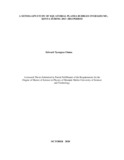| dc.description.abstract | The ionosphereis the ionizedportion of the atmosphere thatstretches from about 50 km to 1000 km above the ground. It plays a very important role in the solar effects felt on Earth.Despite various studies having been carried out on occurrence of Equatorial plasma bubbles (EPBs)in Africa, more researchneeds to be done withinEast Africa since the ionosphere is a highly variable medium resulting from ionizing radiation from the Sun and changes from region to region. The problem in this study wasto investigate the occurrence of EPBs over Kisumu, Kenya during selected quiet and stormdays between1stJanuary 2013 to 31stDecember 2014, which was a high solar activity period for solar cycle 24 using TEC and amplitudescintillation(S4)data. This study wascarried out by analyzing Receiver Independent Exchange (RINEX)Total Electron Content (TEC) data retrievedfrom theKisumu high data rate NovAtel GSV4004BSCINDA-GPS receiver situated at Maseno University(Geographic coordinates: 0.02oS, 34.6oE;geomagnetic coordinates, 9.64oS, 108.59oE). The TEC datawas unzipped using WinRAR program andprocessed using Gopi software. The resulting output data was used to plot Vertical Total Electron Content (VTEC)&S4plotsand ROT &ROTI plotsall against universal time (UT) for selectedquiet and stormdaysof the year 2013 and 2014.The results obtained from this study shows notable TEC depletions followed by TEC enhancement which corresponded with enhanced S4after local sunset for most of the selected quiet and storm days of 2013 and 2014. An average TEC value of 59 TECU was attainedin the equinoctial period(March, April, August and September) while anaverage TEC valueof 55 TECU was attainedin the solstice period(June, July, November and December).There was an increased ROT fluctuation which corresponded with high ROTI values after local sunset for most selected quiet and storm days. The percentage EPBoccurrence was6.49% in the year 2013and 4.32% in the year 2014. The storm days had EPB occurrence of 21.42% in the year 2013 and 21.88% in the year 2014while thequietdayswhich had 18.75%inthe year 2013 and 7.89% inthe year 2014. The storm period had a higher percentage EPBoccurrence than the quiet period and wasattributed to theeffectof prompt penetration electric field(PPEF) which is enhancedduring storms,hence increasing the vertical Ex Bdrift. Seasonal EPB occurrence pattern during quiet and disturbed geomagnetic period was also brought out withMarch equinox having higher percentage EPB occurrence of 33.33% in the year 2013 and 30.76% in the year 2014 while Junesolstice had the lowest percentage of EPB occurrence with 6.67% in the year 2013 and 7.69% in the year 2014.In conclusion, this study confirms the presence of EPBs over Kisumu, Kenya in both quiet and storm days of 2013 and 2014. This study was limited to data from a single SCINDA-GPS station in Kenya, hence future work should involve more SCINDA stations in East Africa and an extension of this study should involve correlation between ROTI daily variabilityof Ex Bvertical plasma drift and F2 layer changes. | en_US |

